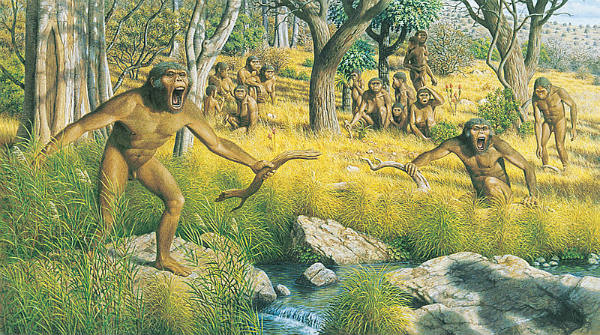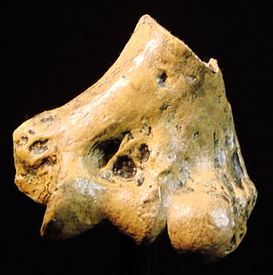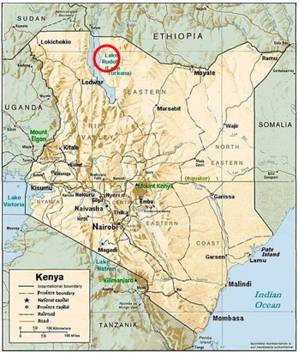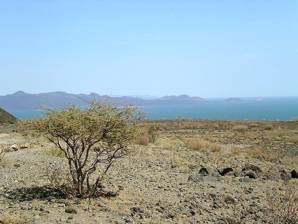Australopithecus anamensis
Online Biology Dictionary
 An Australopithecus anamensis family.
An Australopithecus anamensis family.
|
|
EUGENE M. MCCARTHY, PHD

|
|
Distal humerus of A. anamensis (Kanapoi, Kenya), KNM-KP 271 (Image: Wikimedia) |

|
|
A. anamensis was discovered in nw Kenya |

|
|
Lake Turkana
Image: Ultratomio |
Known specimens of Australopithecus anamensis, which is one of the gracile australopithecines, date to 4.2–3.9 mya. They have been collected from two locales, Kanapoi and Allia Bay, in northwest Kenya, east of Lake Turkana — the name anamensis is derived from the word anam meaning "lake" in the Turkana language.
The lower Kanapoi specimens are between 4.17 and 4.12 million years old and include only cranial material. However, higher in the Kanapoi sequence, but below the locally occurring Kanapoi Tuff, which is about 3.5 million years old, postcranial remains have been found, including a near intact tibia and the distal portion of a humerus (Andrews 1995).
Adjacent to Kanapoi is Allia Bay. A. anamensis material from this locale consists of teeth and mandibular fragments (Coffing, et al. 1994). The Allia Bay fossils were recovered either within the Moiti Tuff (3.9 mya) or beneath it.
The material, most of which was found in the early nineties by Meave Leakey and her associates, was initially assigned to Australopithecus afarensis, but subsequently to anamensis (Leakey et al. 1995), due to perceived differences between the remains of these early Kenyan hominids and the fossils previously attributed to Australopithecus afarensis.
The teeth of Australopithecus anamensis are markedly apelike (large canines, parallel tooth rows), while the postcranial skeleton suggests it was bipedal (Coffing, et al. 1994; Leakey et al. 1995). This combination of apelike cranial traits with probable bipedality is reminiscent of Ardipithecus ramidus.
There is no evidence that anamensis used fire. Nor are any shaped stone tools associated with its remains — the earliest stone tools known date to approximately 2.5 mya (Semaw et al. 1997, Semaw 2000).
The brain size of this hominid is unknown since there is insufficient material to estimate its cranial capacity.
Since anamensis shows similarities to the only slightly older Ardipithecus ramidus, which dates to 4.4 mya, it will be interesting to see whether the two continue, in the long run, to be treated as distinct.
Perhaps we are not from the apes alone?
Learn more >>

|
|
Habitat: Savanna-forest mosaic. Pronunciation: AWS-trail-ō-PITH-ə-kəs awn-ə-MEN-səs. Etymology: The name of this hominid is constructed from the Latin prefix australo-, the Greek suffix -pithecus, the Latin suffix -ensis, and the word anam meaning "lake" in the Turkana language. So this hominid's name means "Southern ape of the lake". |
Interesting facts about other members of genus Homo:
Australopithecus bahrelghazali >>